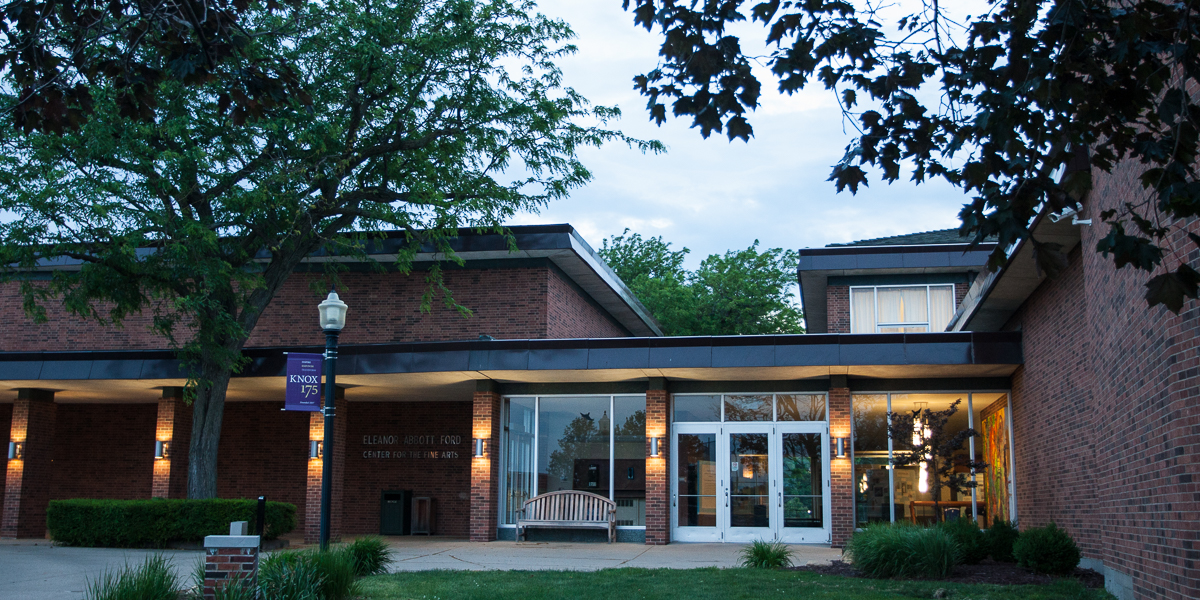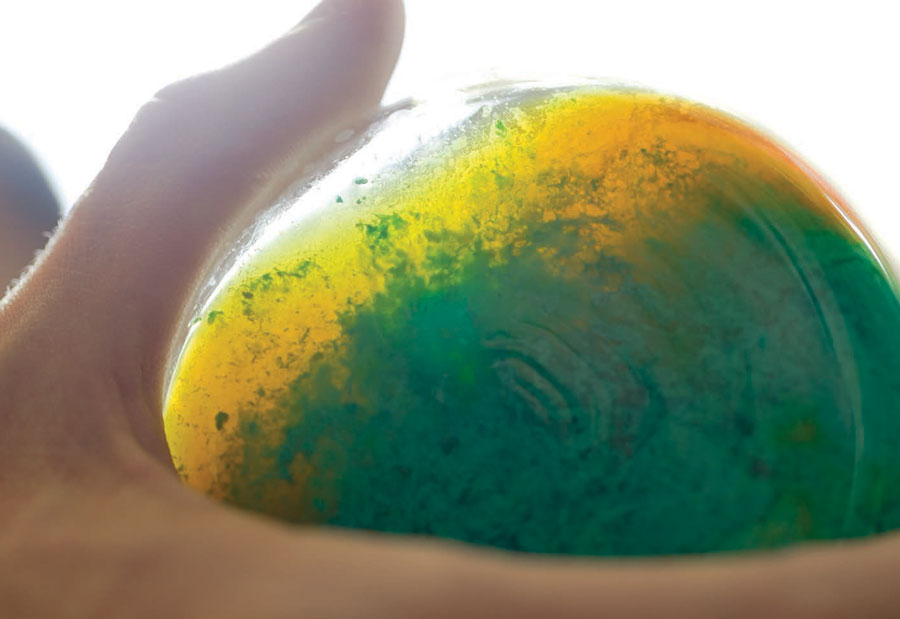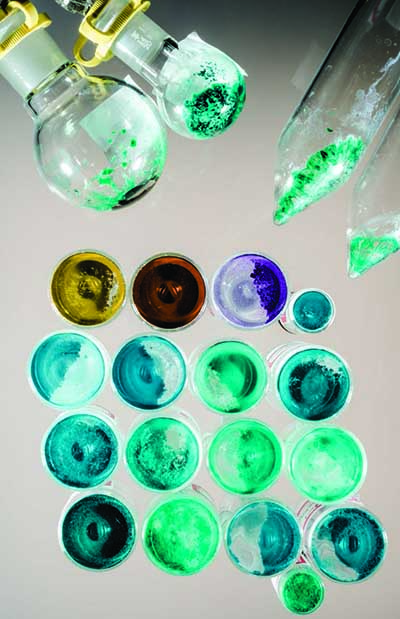

Venture Boldly


Text By Pam Chozen
Photos By Evan Temchin '10
Senior Brad Musselman usually carries his Honors project, the culmination of four years of chemistry courses and seven months of intensive experimentation, in a cardboard box. It holds an array of sample dishes, each with a thin crust of blue, blue-green, purple, gold, or amber on the bottom. Those brilliantly colored substances are liquid crystals, similar in some respects to the liquid crystals you’ll find inside smartphone touchscreens, LEDs, photovoltaic batteries, and ultra-thin high-definition televisions. The objective of Musselman’s research was to develop a method of synthesizing a novel form of copper-based liquid crystal with subtle structural and functional changes, such as a lower melting point, that could potentially have practical applications in the future. What his box holds, in fact, are chemical compounds that didn’t exist before Musselman created them in the lab.
 The official title of his project is “Axial Site Reactivity of Multinuclear Copper (II) Carboxylate Metallomesogens;” if all goes according to plan, you’ll find it listed among the other College Honors in this year’s Commencement program. Under the guidance of chemistry professor Tom Clayton, he’s been exploring the behavior of liquid crystals since arriving at Knox. The summer after Musselman’s first year, he volunteered to work in Clayton’s lab for free so he could continue to experiment. Fortunately, in subsequent years, Musselman was able to secure institutional support for his summer work. In addition to receiving the Glenn M. Nagel Undergraduate Research Fund Award in Chemistry, he obtained funding from Knox’s Vovis Center for Research and Advanced Study, including a Paul K. Richter and Evalyn Elizabeth Cook Richter Memorial Fund Scholarship for summer research and was selected for the Artists, Scholars, Scientists, & Entrepreneurs of Tomorrow (ASSET) program for high-achieving students pursuing intensive individual projects.
The official title of his project is “Axial Site Reactivity of Multinuclear Copper (II) Carboxylate Metallomesogens;” if all goes according to plan, you’ll find it listed among the other College Honors in this year’s Commencement program. Under the guidance of chemistry professor Tom Clayton, he’s been exploring the behavior of liquid crystals since arriving at Knox. The summer after Musselman’s first year, he volunteered to work in Clayton’s lab for free so he could continue to experiment. Fortunately, in subsequent years, Musselman was able to secure institutional support for his summer work. In addition to receiving the Glenn M. Nagel Undergraduate Research Fund Award in Chemistry, he obtained funding from Knox’s Vovis Center for Research and Advanced Study, including a Paul K. Richter and Evalyn Elizabeth Cook Richter Memorial Fund Scholarship for summer research and was selected for the Artists, Scholars, Scientists, & Entrepreneurs of Tomorrow (ASSET) program for high-achieving students pursuing intensive individual projects.
Others have been able to synthesize liquid crystals from copper since the 1960s. “But they were always kind of crummy,” says Musselman. “They decomposed quickly. I thought, wouldn’t it be great to make them better—decrease the melting point, improve the viscosity?” He went through months of trial and error, carefully weighing out different amounts of copper, caprolactam (a precursor of nylon), and solvent, mixing them together, heating them, and then carefully watching for the exact moment when the compound developed a crystalline structure—a transformation marked by a vivid shift in color.
Once he hit upon the right formula, he then had to prove the substance he’d created was exactly what he claimed it was, replicating the experiment again and again, carefully monitoring temperatures and using X-ray diffraction and infrared (IR) spectroscopy to verify the molecular makeup of the new compound. Based on what he observed, he was able to draw conclusions about exactly what it was about the new substance’s structure (the “axial sites” referenced in the project title) that enabled it to transform from solid to liquid at a lower temperature.
This is, of course, a wildly simplified explanation of what’s happening inside Musselman’s flasks.
Brad Musselman is only the latest of Tom Clayton’s students to investigate the behavior of copper dimers. The chemistry professor has been studying transition metals since he first arrived at Knox in 1991, and Musselman’s project is just the latest addition to 25 years of research conducted by him and his students. As in the labs of many of Clayton’s Knox colleagues, Clayton’s students don’t merely assist him in his own experiments; under his supervision, they learn how to design and conduct their own research. This approach has both advantages— promising students get a head start on the sort of work they’ll perform as graduate students and professional research scientists—as well as some limitations. “Undergraduate research moves at a slow pace,” observes Clayton, “but publishable results have emerged from the careful notebooks of several gifted students.”
Nonetheless, his lab’s track record is impressive. Musselman’s is the 20th Honors project he has supervised. Thirteen of his students have gone on to earn doctorates in chemistry; three others have graduated from medical school. (These results are consistent with Knox’s entire chemistry department, which has ranked among the top 25 undergraduate U.S. chemistry programs in terms of Ph.D. production since the mid-1970s.) For his part, Musselman has already been accepted into doctoral programs at University of Chicago, University of Michigan, and University of Pennsylvania. He thinks he may want to teach eventually.
Clayton and future Knox chemistry students will continue to build upon Musselman’s research. Clayton thinks it could conceivably be possible for liquid crystals like these to be used in their fluid phase as the reaction medium for some commercial processes, which could potentially reduce chemical waste by eliminating the need for solvents. He also expects many more students to make the transition from his lab to Ph.D. programs around the country. “I’m not a stern authority,” he laughs. “Mostly I ask that they keep things operating safely. It makes for a productive student culture. And it prepares them for the independence of grad school.”
6
years on the Forbes Grateful Grads Index
where alumni feel they received the greatest return on their college investment